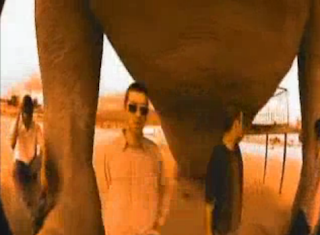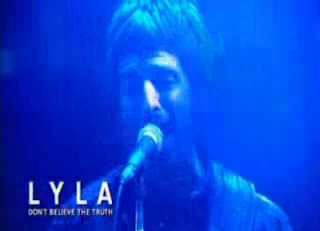Lock The Box was a documentary that was included on a bonus DVD that came packaged with Oasis's 2006 greatest hits album, Stop The Clocks.
Type of Documentary
Lock The Box is a mixed documentary: it includes features such as interviews, cutaways, archive footage and observation. One difference from most documentaries of this type is that the interviewer (Colin Murray) can often be heard and occasionally seen talking to the band, which helps add to the friendly, light hearted mood of the documentary as he is often heard and seen joking with Noel and Liam Gallagher.
Part one of Lock The Box, from YouTube.
Themes
Themes within Lock The Box include music, Oasis, fan bases and success. As the documentary was part of Oasis's greatest hits, it also has themes of things like celebration as all of the songs discussed are considered to be the band's 'best' songs in their own opinion and therefore they have a mainly positive attitude towards all of the songs that they discuss.
The album and documentary were a celebration of Oasis's finest work, and as a result there is a strong theme of celebration and success which is reflected in the large amount of archive material used in the documentary used to showcase and prove this undeniable success to the viewer. The documentary was made to work alongside the album, and as a result nearly everything discussed in the documentary has some relevance to the album.
Narrative Structure
Lock The Box had a linear narrative with a clear beginning, middle and end. The beginning of the documentary was short, quickly introducing the viewer to the 'best of' idea of the Stop The Clocks album, how the band wanted it to be based off what they considered to be their finest work instead of their actual 'hits' (for example, their 1997 single 'D'you Know What I Mean' went straight to number one in the UK singles chart but is not included on the compilation, whereas songs such as 'The Masterplan' and 'Half The World Away' are included despite them originally being B-Sides). This quick beginning to the documentary instantly tells the viewer what the rest of the documentary is going to be about and answers many questions that one may be asking straight away, such as the logic in the selection of the track listing. The middle of the documentary is the bulk of it, where one by one each of the eighteen tracks on the Stop The Clocks album are worked through by the band and interviewer, with each track being discussed in some detail - for example, the origins of the tracks or stories related to them are told by the band. In between discussions of the tracks, banter between the Gallagher brothers, the interviewer and the crew is shown to split up the action and add to the friendly and cheerful atmosphere of the documentary. The end of the documentary concludes what has already been said, briefly shows the band suggesting other songs that they would've liked to be on the album that had to be cut for whatever reason and them expressing how they would like to do another similar documentary 'in ten years' time' (Oasis split up in 2009).
The documentary works through each of the album's eighteen tracks one by one, including commentary on each track by the band members and the interviewer. Each track is discussed for a few minutes before a new track is introduced, which keeps the narrative of the documentary interesting for the viewer as it is varied and does not drag on too much (The documentary is only forty minutes long).
Short interludes in between most tracks show the band joking and having seemingly random conversations with the interviewer and his crew, which provides entertainment for the viewer and helps break up the action.
Camera Work
A two shot of Noel and Liam Gallagher is frequently used in the interviews - this shows them next to each other and at equal levels which creates a friendly relationship and equilibrium between the two brothers. It also shows the only two members of Oasis who were in the band for it's entire lifetime (1994-2009), so in a sense the Gallagher brothers represent Oasis as a whole. In other Oasis documentaries they are often shown being interviewed separately, away from each other, and the way in which they are interviewed together in Lock The Box could've been a request of the record label or band in order to ease any rumours that the band may have fallen out or may be coming to an end, as the Gallagher brother's turbulent relationship was often acknowledged by the media and public - they appear as equals and friends through the use of the two shot in Lock The Box, and are seen reacting to what one another say and joking with each other. Camera angles in music videos and live performances are also seen, including zoom shots, handheld static cameras and long shots to show the entire band playing. A long shot of the room where the interview is taking place is also seen, breaking the fourth wall as the interviewer and crew can be seen in this shot. When just one of the brothers is speaking, a close up of their face is often used, and a static pan shot occasionally switches between the two brothers in a shot reverse shot style. Cameras in live performances and music videos are often low angle shots to make the band appears powerful from the perspective of the audience, and include other varieties of shot such as canted shots, zooms, and static cameras.
Two shots were used to create a friendly relationship between Noel (left) and Liam (right) Gallagher, and allowed both brothers to speak and express their thoughts at once as well as interact with each other.
Low angle shots looking up at the band from the crowd's viewpoint made them appear more powerful.
Zooming was used to focus attention on just one of the brothers, when they were the only one speaking for example.
Mise en Scené
The background of the interview was always a stylish and quite ordinary blue backdrop - this was suitable as it drew attention to the Gallagher brothers, what they were saying, and their reactions to things rather than a distracting image in the background. Sometimes the entire room was shown, with all of the crew members seemingly enjoying themselves and having a joke, which added to the friendly atmosphere of the documentary. The room in which the interview was taking place also matched the title of the documentary - Lock The Box - as this creates an image of isolation and the interview appeared to be taking place in a small box-shaped room with very little in it, as if they had indeed been locked in a box. The mise en scené in the music videos and the live footage usually placed the band at the centre of attention.
The plain background and surroundings drew attention to the reactions and words of the band.
Sound
Diegetic sound led the narrative with the voices of the interviewees and the interviewer. Ambient sound, natural sound from the interviews was also present. Non diegetic sound - namely music - in the form of the song on its own, from a music video, or from live performances was heard through much of the documentary to match the theme of Oasis and their music. Every song that was played was indeed an Oasis song and only songs that were included on the album were used - occasionally, live performances were used instead of studio recordings to help showcase their career more.
Live recordings, such as this performance of 'Talk Tonight' from 1995 were used to help keep the sound varied for the viewer and to help showcase Oasis's careers so far over all of their years of existence, matching the idea that the album is very much a retrospective.
Editing
Fast transactions between sections kept the pace of the documentary steady, as the editing was generally quite slow paced with long cuts to match the calm and humorous mood and atmosphere of the documentary. A two shot to show both Gallagher brothers at once was frequently used to create equilibrium and friendship between them. Cutaways were frequently used to help display the large collection of archive footage. Montages were also used to show a collection of videos, live clips or still images. Short interludes were included in between most songs to break up the action by showing friendly interactions between the band members and the crew. Editing within music videos and live performances was also visible, include things such as fades and black and white shots.
Quick montages worked as transitions between sections, showing a short collection of images and video clips.
Editing in music videos is also seen, such as the black and white images seen in the 'Supersonic' video.
Archive Material
Nearly all of Lock The Box consisted of archive material. Interviews and 'behind the scenes' shots of the cast in front of the band were shown, and footage of live performances and music videos as well as the music itself were used throughout the documentary to help showcase the band's career and to stick to them themes of music and Oasis. Still images were also displayed at times, and other non-musical footage such as footage from videos of the band from past years.
The most commonly used archive footage in Lock The Box was footage of live performances and music videos. This footage kept the documentary varied and stuck to the theme of the it being a retrospective of Oasis's careers up to that point.
Images and videos from past Oasis interviews and shows were also used to help support the idea of the documentary being a summary of Oasis's careers.
Graphics
As is the case with many documentaries, white text was used on a darker background to make it stand out without it being too distracting. The writing used the traditional 'Oasis' font found on many of their album covers and other releases. A graphic is used to introduce most songs and quick transitions consisting of images and video footage were used as a bridge between sections.
White text on a darker background was used as it stood out. The way in which the letters are spaced out and the font used matched the way most things are written on most official Oasis releases, reminding the viewer that this was an official release and matching the Oasis theme of the documentary.












No comments:
Post a Comment